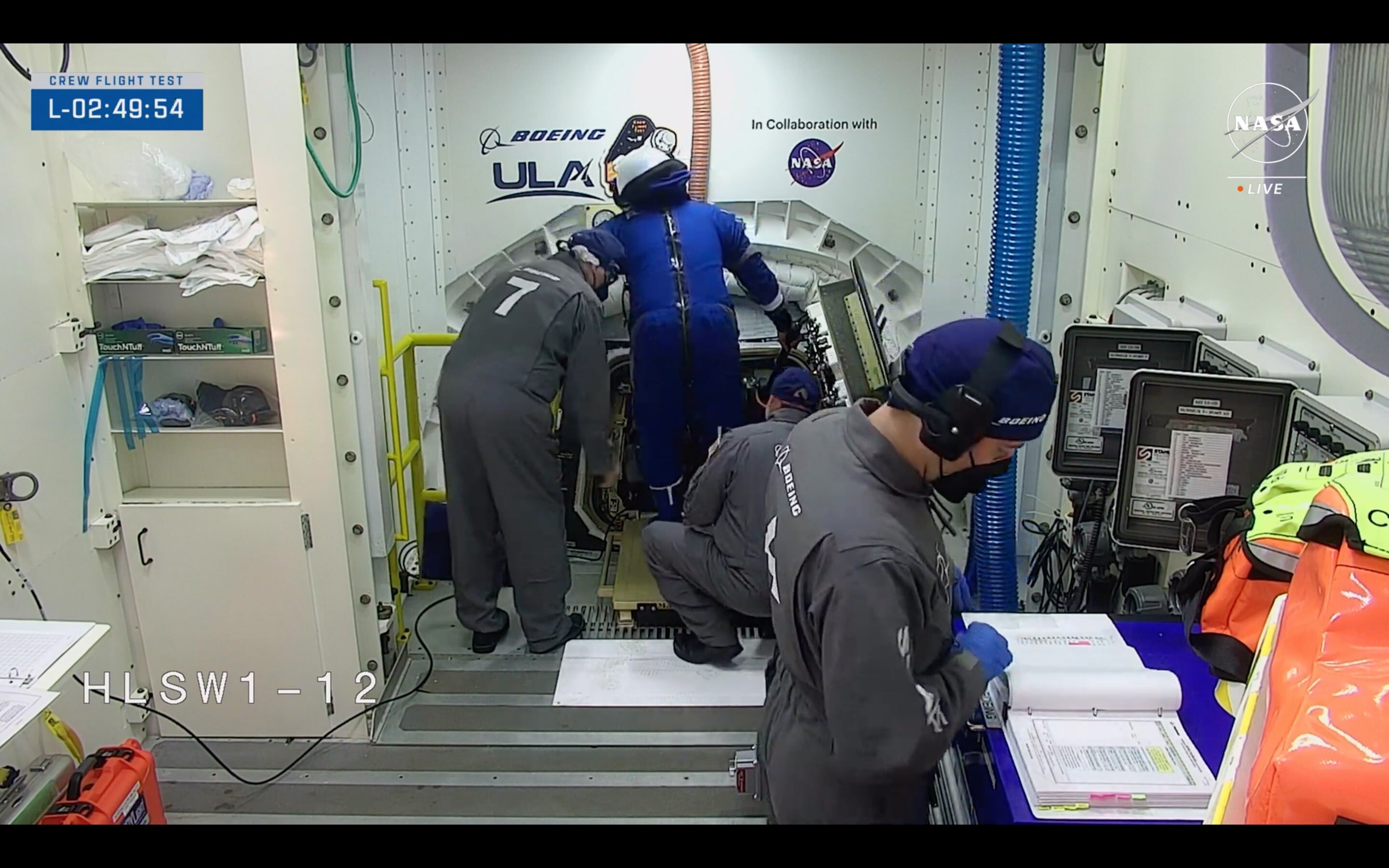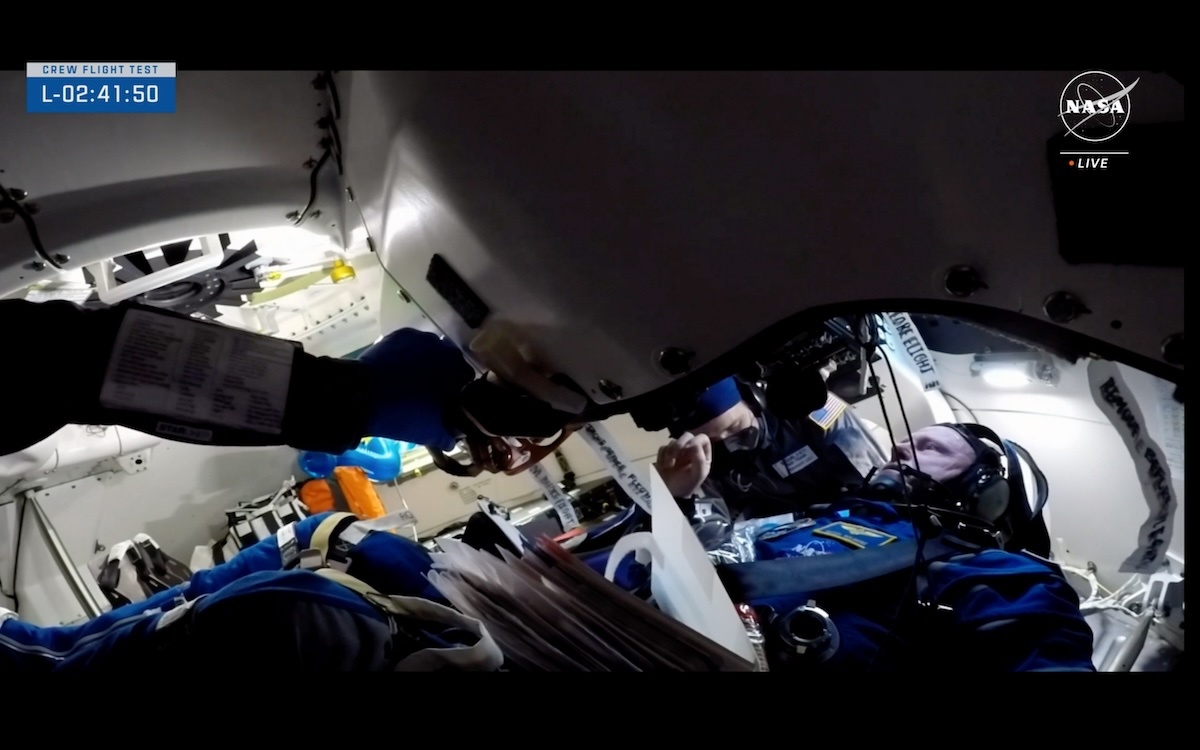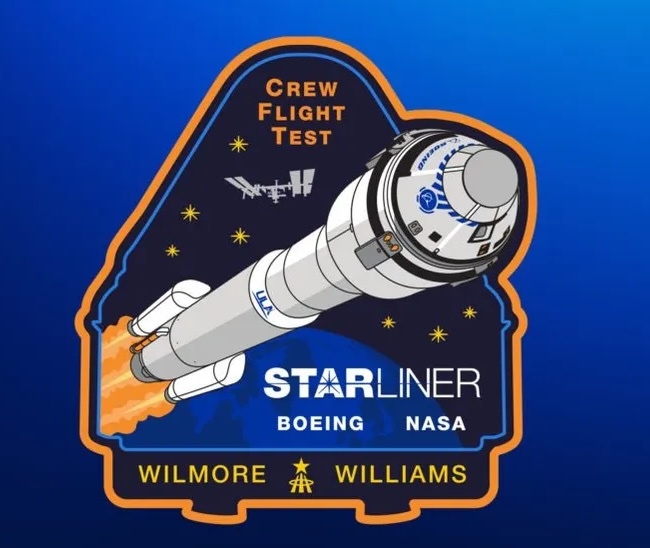"And every now and again, in rare occasions, a valve like that can get into a position where it's just off the seat. Its temperature, its stiffness, everything is just right. And it'll flutter. Or it'll buzz — in this case — in cycle," he said.
Explaining a possible repair scenario, Bruno said ULA crews would roll the rocket off the pad back into the company's nearby Vertical Integration Facility at Launch Complex 41; support and "stretch" the Centaur stage; replace the valve without having to remove the Starliner capsule; and roll the rocket back to the pad.
"Overall, things were going really well in the launch countdown. In fact, we were a little bit ahead of the timeline and talking about maybe being able to close the hatch a little bit early," Stich said.
Ken Bowersox, NASA’s Space Operations Mission Directorate associate administrator, said the liquid-oxygen valve issue violated flight rules and prompted crews to begin troubleshooting.
"Good things are worth waiting for. And we'll get a chance to see that rocket and spacecraft lift off the pad here soon," Bowersox said.
In its Tuesday night statement, ULA officials said, "NASA astronauts Butch Wilmore and Suni Williams will remain at crew quarters in health stabilization until the next launch opportunity."
Quelle: Florida Today
----
Update: 14.05.2024
.
Friday launch possible for Alabama Atlas-V, despite reported arguments over the rocket
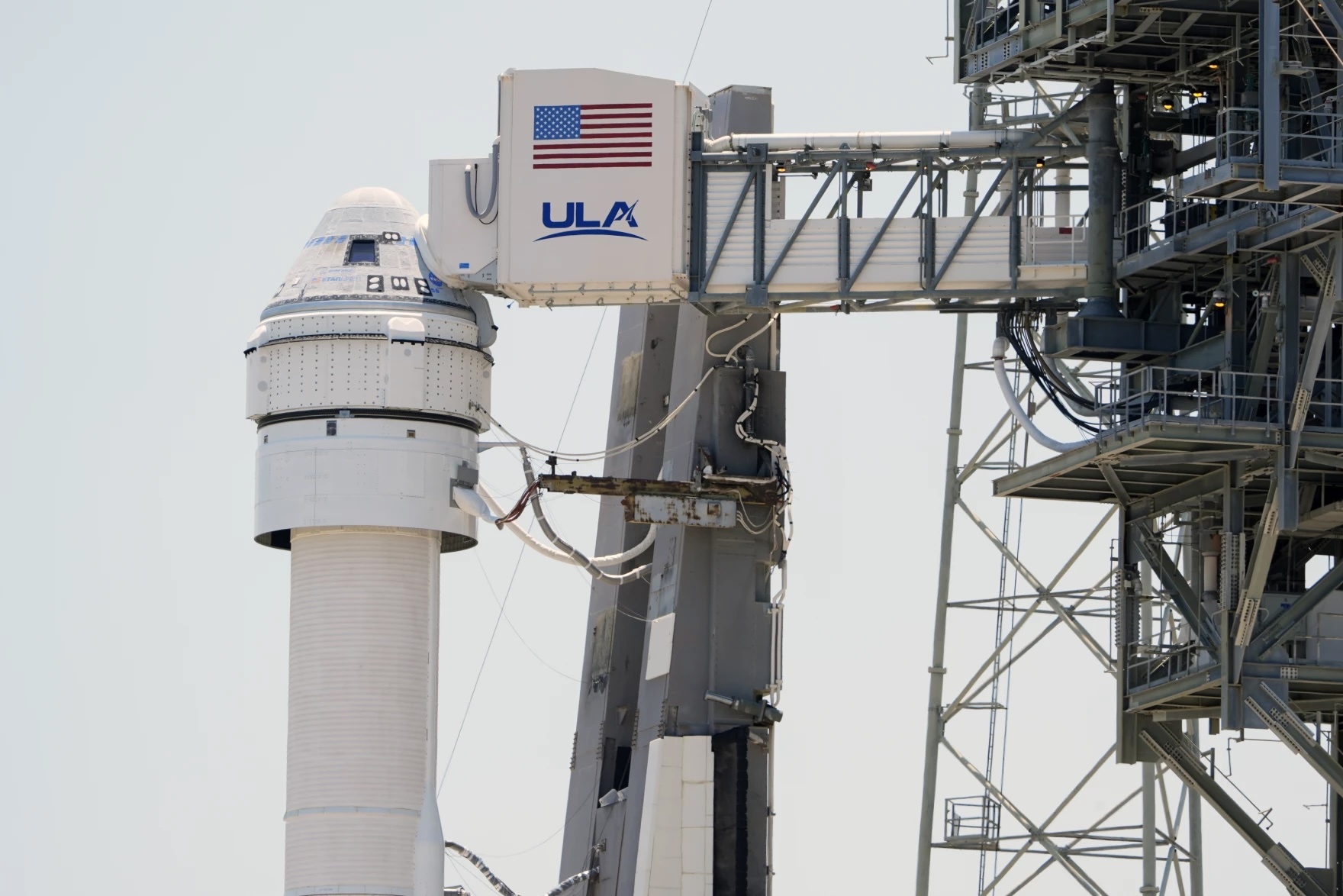
Boeing's Starliner capsule atop an Atlas V rocket is seen at Space Launch Complex 41 at the Cape Canaveral Space Force Station a day after its mission to the International Space Station was scrubbed because of an issue with a pressure regulation valve, Tuesday, May 7, 2024, in Cape Canaveral, Fla. (AP Photo/John Raoux)
NASA, Boeing, and Alabama rocket builder United Launch Alliance are still shooting for this Friday (at the earliest,) for the blastoff of an Atlas-V. The rocket is supposed to carry a new space capsule called Starliner. That flight has been delayed since early last week because of a value issue on the rocket built at the ULA factory in Decatur. The cancellation, known as a “scrub,” meant NASA and the space agency’s supporters will have to wait to see the first test launch of the Starliner, with astronauts on board.
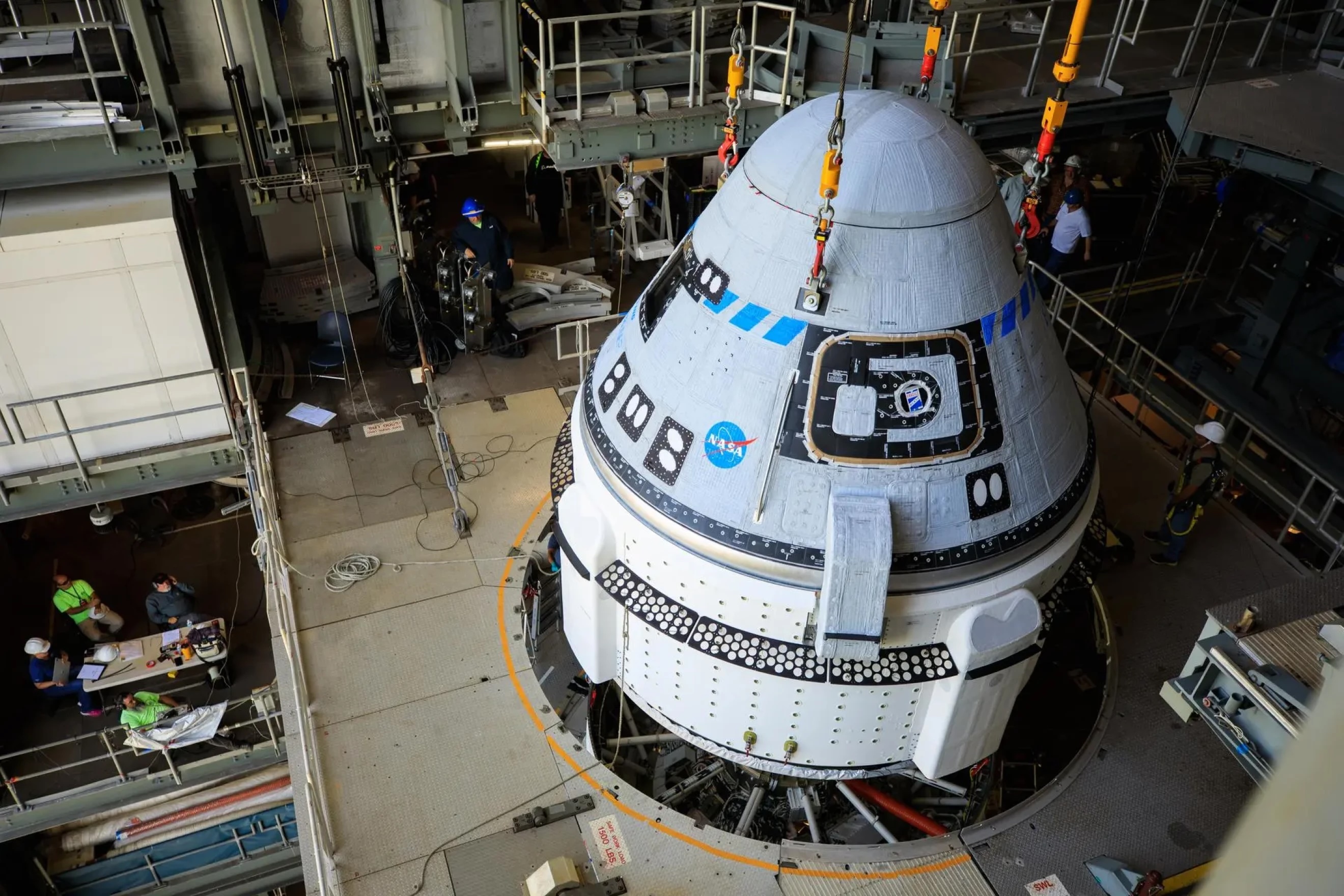
This is the first time people have flown on an Alabama built Atlas-V. Previous unmanned launches of this this type of rocket have included the New Horizons spacecraft to Pluto, the Mars InSight lander, and the Osiris Rex mission to gather rock and soil samples from an asteroid called Bennu. Ironically, if there was an unmanned payload on the launch pad last week, the Atlas might have blasted off.
Tory Bruno is President and CEO of United Launch Alliance. That’s the company that built the Atlas-V in Alabama. He says Starliner prompted engineers to load the rocket with extra safeguards and launch safety procedures that would apply if there were astronauts aboard.
“And like I said, if it were a satellite, we would have simply cycled the valve, the buzzing would have stopped, finished the count in lunged. That's not what we planned for crew mission. And so we stayed with the rules and the procedures and scrubbed as a result,” he said.

When Starliner’s launch was called off, Former Astronaut Ken Bowersox spoke with the press. He’s the Associate administrator of NASA's Space Operations Mission Directorate. "Good things are worth waiting for. And we'll get a chance to see that rocket and spacecraft lift off the pad here soon," he said.
It bears noting that Bowersox commanded space shuttle Columbia on science mission in orbit in 1995. It was called STS-73, and its eventual blastoff was delayed six times because of bad weather. As tedious as that sounds, it’s not even the record for the most launch scrubs. It tied another Columbia mission back in 1986 that was delayed six times as well. STS-61C was the last shuttle to fly before the 1986 Challenger explosion that killed seven astronauts. One of the astronauts aboard that much delayed Columbia mission was then U.S. Congressman Bill Nelson. He's now NASA's top administrator.
One person who appeared ready for a delay or two is Dana Weigel, NASA’s International Space Station Program Manager. The orbiting outpost is Starliner’s ultimate destination, with the new vehicle docking on a mission scheduled to last a week or so. Weigel says the space station program knows this is a test flight and made room for the new spacecraft to make the trip.
We're not in a rush to fly from a station standpoint, we did clear our summer schedule intentionally to give us plenty of runway for the CFT (Crew Flight Test) mission,” said Weigel. “Our next docking vehicle comes up in August. So, plenty of time when CFT is ready to fly, when you will a Boeing and ULA (United Launch Alliance) give that final GO station will be ready for CFT to come on board.”
NASA hired both Boeing and SpaceX to build U.S. spacecraft to carry astronauts to and from the International Space Station. The SpaceX “Crew Dragon” capsule has ferried crews on a series of successful missions. Boeing’s Starliner, by contrast, has yet to fly a crew. Unmanned missions have been plagued with technical issues, including software problems and concerns with the parachute harnesses meant to cushion the Starliner’s descent and eventual touchdown on solid ground.
Quelle: Alabama Public Radio
----
Update: 15.05.2024
.
What's behind latest delay of Boeing Starliner launch from Florida?
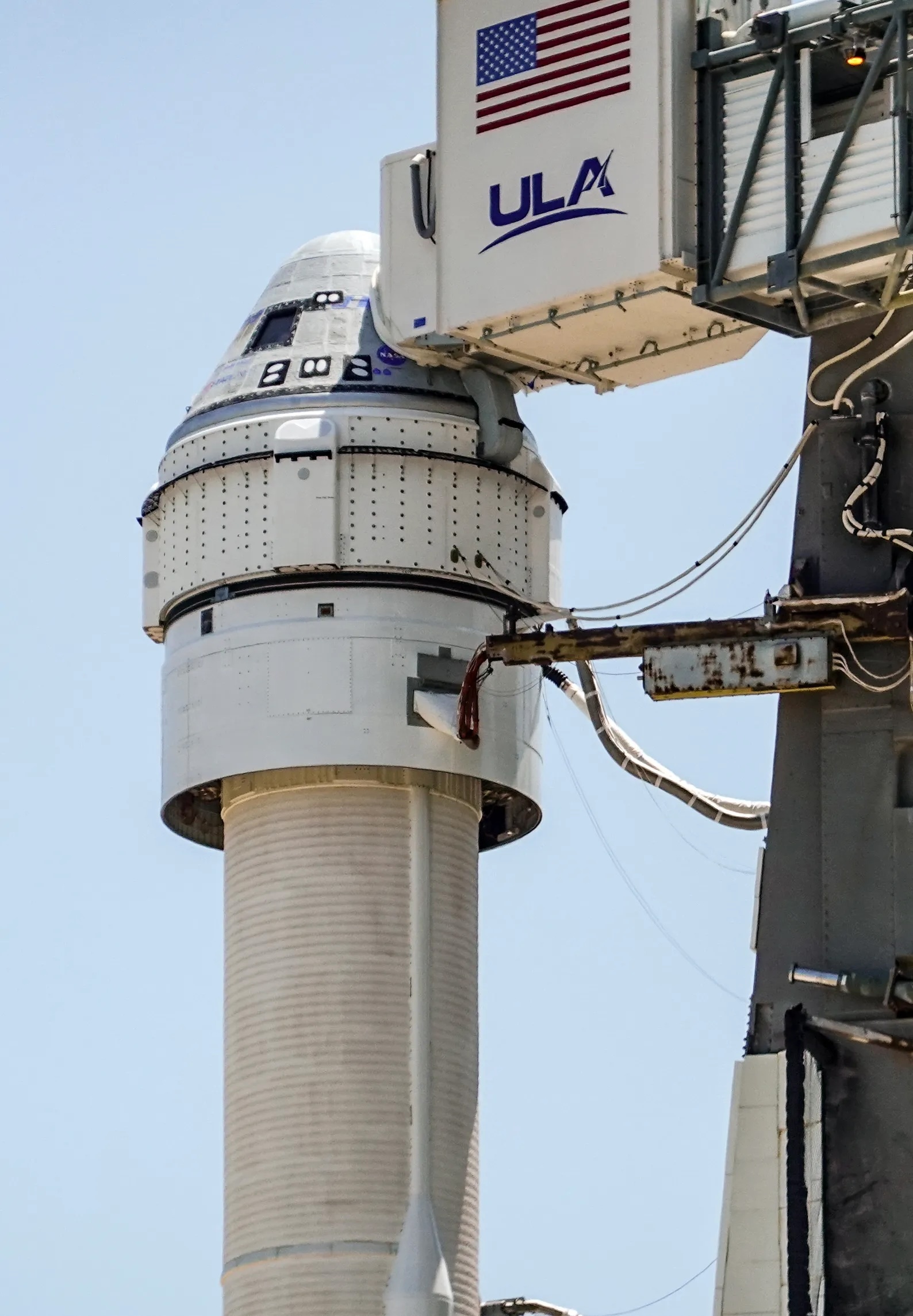
After making it to the launch pad earlier this month only to face an issue with the Atlas V rocket, this week's planned launch of Boeing’s Starliner from Cape Canaveral is delayed yet again − now the inaugural crewed flight is set for no earlier than Tuesday, May 21st.
Originally set for May 6, the launch was scrubbed when a faulty oxygen valve on the Atlas V was discovered with almost two hours left until launch. The crew was in the process of getting in the spacecraft when teams called off the launch to investigate the valve.
United Launch Alliance teams decided to replace the valve and to do so required rolling the rocket and the attached Starliner back to the Vertical Integration Facility.
With the valve replaced May 11, the plan was to push ahead toward a launch this Friday, but now another issue has cropped up: this time on the spacecraft itself.
Latest delay on Starliner due helium leak on Starliner
A statement released by Boeing said that a small helium leak was detected in the spacecraft’s service module — the disposable module which sits below the spacecraft and contains the thrusters and launch abort engines.
The helium leak was found to be coming from a "flange on a single reaction control system thruster." While helium is not reactive, it is used within thrusters to assist in firing. In order to ensure the safety of the spacecraft, the Boeing team states they plan to fully investigate the leak and that means bringing Starliner’s propulsion system to the state seen before launch.
Boeing added that they aren't currently tracking any other issues with the spacecraft.
Rocket valve caused initial delay
The initial delay was prompted by an issue with an oxygen valve on the Atlas V rocket.
"And every now and again, in rare occasions, a valve like that can get into a position where it's just off the seat. Its temperature, its stiffness, everything is just right. And it'll flutter. Or it'll buzz — in this case — in cycle," ULA President Tory Bruno said during a press conference which followed the May 6 night scrub.
"We've seen that before," said Bruno. "What you would typically do is activate the solenoid that forces the valve closed − cycling the valve, if you will − then you turn that on and let it return.”
But with a crew involved, the launch had to be stopped for the day. The astronauts were never in any danger, officials noted.
The next day ULA crews investigated the valve issue, only to make the call later in the day to replace it.
New Starliner launch date
The launch of Starliner is now set for no earlier than 4:43 p.m. Tuesday, May 21 at 4:43 p.m. The astronauts, Butch Wilmore and Suni Williams, reportedly returned to Houston to be with their families and now plan to return to Florida in the coming days.
Quelle: Florida Today
----
Update: 19.05.2024
.
Starliner delays continue. Crewed launch now set for no earlier than May 25
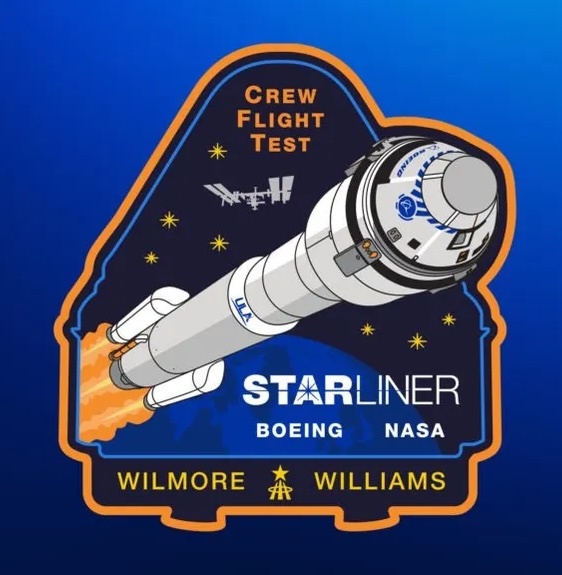
Those who made plans to watch Starliner lift off on Tuesday will need to adjust. Starliner is again facing a delay.
After the maiden crewed launch of Boeing's Starliner was scrubbed May 6, the rocket was rolled back off the launch pad for United Launch Alliance crews to replace a faulty oxygen valve on the second stage of the rocket. The new launch date of no earlier than May 17 was given, yet Boeing crews discovered an issue on the spacecraft. Launch was changed for no earlier than Tuesday, May 21.
But Friday NASA officials stated that Starliner will now target a launch of no sooner than 3:09 p.m. EDT on Saturday, May 25.
Starliner, which will ferry NASA astronauts to the International Space Station alongside SpaceX after certification, has faced multiple delays over the past two years as it headed for the launch pad. Finally mounted atop the Atlas V rocket at Launch Complex 41, those delays continue.
On May 6, as NASA astronauts Butch Willmore and Suni Williams boarded the spacecraft for the first crewed test flight, a "flutter" was seen with an oxygen valve on the ULA Atlas V rocket's upper stage. With crew onboard, protocol called for a scrub to ensure crew safety.
"We've seen that before," said ULA's Tory Bruno during a post scrub press conference. "What you would typically do is activate the solenoid that forces the valve closed − cycling the valve, if you will − then you turn that on and let it return.”
ULA crews inspected the issue through the next day before announcing they would roll the Atlas V rocket back to the Vertical Integration Facility (VIF) and replace the troublesome oxygen valve.
What has caused the latest delay to launch Starliner?
On May 11, while crews were working on the rocket's upper stage, a helium leak was detected coming from the Starliner service module, which is the disposable lower part of the spacecraft containing engines and thrusters. The Boeing team narrowed down the cause of the leak to a single reaction control system thruster in the service module, and called for a launch attempt no sooner than Tuesday, May 21.
Boeing stated that no other issues were found with the spacecraft after an analysis of the May 6th data.
On Friday, NASA said Boeing was going to take more time before launch, thus the new target of May 25.
"The testing also indicated the rest of the thruster system is sealed effectively across the entire service module. Boeing teams are working to develop operational procedures to ensure the system retains sufficient performance capability and appropriate redundancy during the flight," NASA said.
For now, the astronauts will remain in quarantine at Johnson Space Center in Houston. The astronauts, Williams and Wilmore, will fly back to Cape Canaveral when the new launch date approaches.
Quelle: Florida Today
----
Update: 23.05.2024
.
Starliner crewed test flight remains on hold
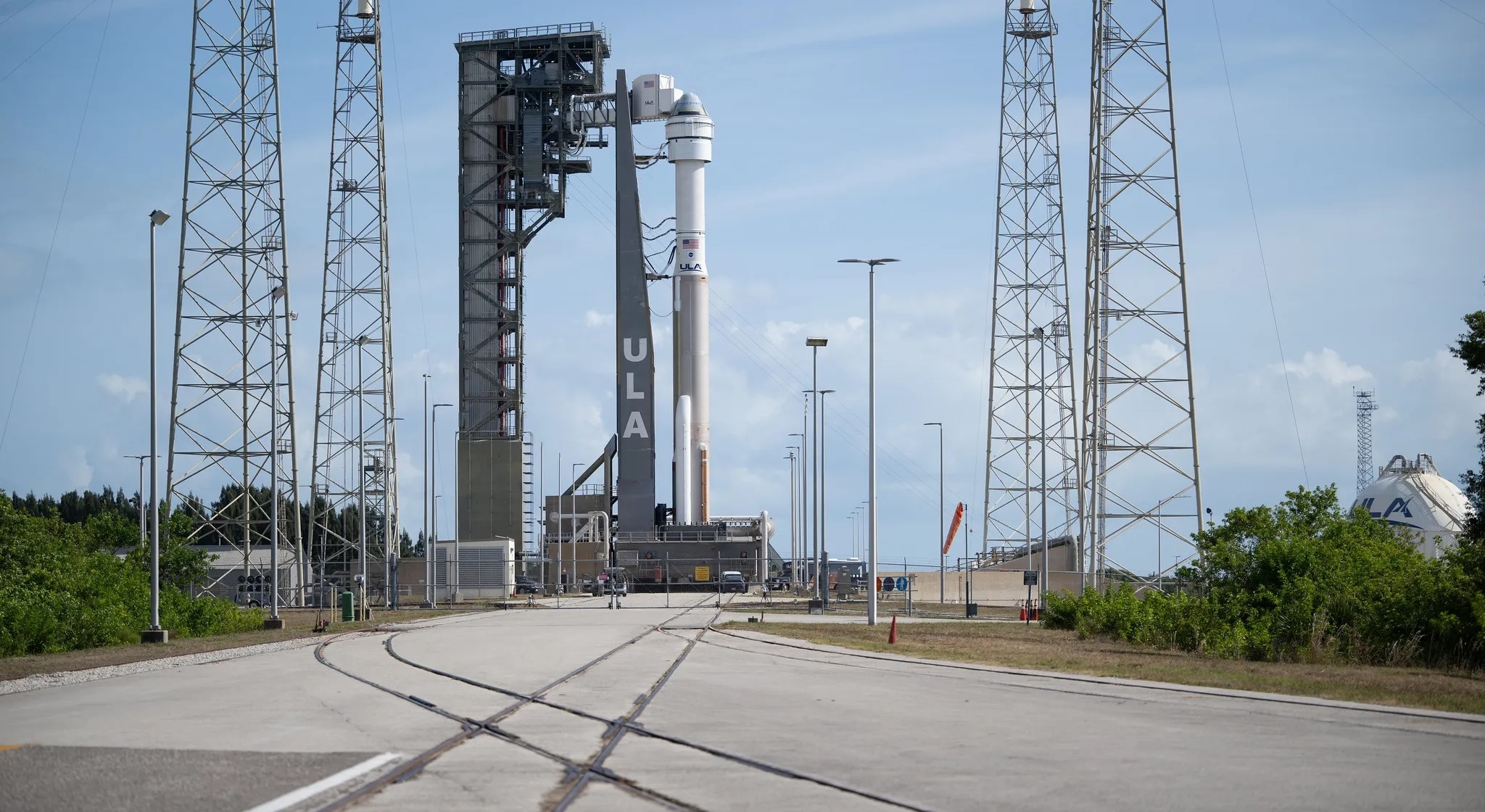
The Atlas 5 rocket and Starliner spacecraft on the pad before the scrubbed May 6 launch. Credit: NASA/Joel Kowsky
WASHINGTON — NASA and Boeing have further delayed the launch of a crewed test flight of the company’s CST-100 Starliner spacecraft, this time not offering a new launch date as work to resolve a helium leak continues.
In a statement issued on the evening of May 21, NASA said it, along with Boeing and United Launch Alliance, would not proceed with a planned May 25 launch of the spacecraft on the Crew Flight Test (CFT) mission with two NASA astronauts on board. That launch has suffered several delays stemming from a helium leak in the spacecraft’s propulsion system.
Unlike previous delays, NASA did not announce a new launch date for the mission. “The team has been in meetings for two consecutive days, assessing flight rationale, system performance, and redundancy,” the agency stated. “There is still forward work in these areas, and the next possible launch opportunity is still being discussed.”
“NASA will share more details once we have a clearer path forward,” the statement concluded.
NASA first revealed the helium leak, linked to a flange in a thruster in the spacecraft’s service module, May 14. At the time the agency said it would delay the CFT launch from May 17 to May 21 to given engineers time to characterize the leak and develop a flight rationale to fly the system as-is.
Late May 17, though, NASA said it would push back the launch to May 25. While Boeing engineers determined the leak was stable and not a flight risk, NASA said the company was “working to develop operational procedures to ensure the system retains sufficient performance capability and appropriate redundancy during the flight.”
The latest NASA statement provided no other information about the helium leak or efforts to clear the vehicle for flight, including any specific concerns that may have triggered this latest, indefinite delay. NASA and Boeing have limited updates about the mission’s status to brief statements and have not held any briefings since immediately after the scrubbed May 6 launch attempt. Boeing spokespersons did not answer questions last week about the helium leak.
It is unclear what an extended delay would mean for the mission. NASA officials previously said they had cleared the International Space Station’s schedule until August to give them plenty of flexibility to schedule the arrival of Starliner, which would be docked to the station for a week or more. However, it is less certain how long Starliner can remain stacked on its Atlas 5 rocket before needing refurbishment.
Quelle: SN
----
Update: 24.05.2024
.
NASA, Boeing and ULA announce June 1 as new target date for Starliner’s Crew Flight Test
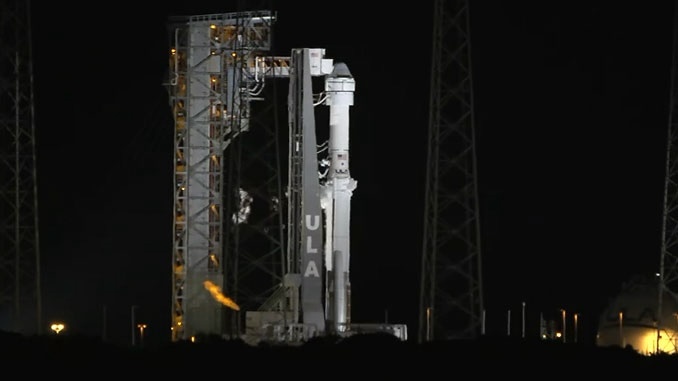
NASA is looking at the start of June for its next attempt to launch its astronauts, Butch Wilmore and Suni Williams, on board Boeing’s Starliner spacecraft. The announcement came last Wednesday night in a blog post, stating that June 1 will be the earliest that the Crew Flight Test of Starliner can begin.
The new launch date has a T-0 liftoff of 12:25 p.m. EDT (1625 UTC). There are also backup opportunities available on Sunday, June 2; Wednesday, June 5; and Thursday, June 6.
The May 6 launch date was originally scrubbed about two hours prior to launch due to an issue with an oxygen pressure release valve on the upper stage of United Launch Alliance’s Atlas 5 rocket. That issue was resolved on May 11 after rolling the rocket back to ULA’s Vertical Integration Facility and swapping it out.
However, the launch delay persisted as Boeing was assessing a helium leak connected to a flange on one of the reaction control thrusters on the Starliner spacecraft’s service module. There are a series of thrusters within four chambers on the exterior of the service module called “doghouses.”
The cryogenic helium is used to pressurize the propulsion system on the service module and ensure that the propellant and oxidizer flow as needed to their respective thrusters and the launch abort engines.
The leak was initially believed to be within flight limits and wouldn’t have led to a mission scrub on May 6, which was demonstrated through a pressure test done in the VIF on May 15. But on May 17, NASA and Boeing delayed the mission until May 25, citing the need for Boeing to “develop operational procedures to ensure the system retains sufficient performance capability and appropriate redundancy during the flight.”
The weekend rolled by without any further updates and on May 21, following multiple requests from members of the press for more information, a NASA spokesperson confirmed that May 25 was off the table.
“The team has been in meetings for two consecutive days, assessing flight rationale, system performance, and redundancy. There is still forward work in these areas, and the next possible launch opportunity is still being discussed,” a NASA spokesperson said.
On May 22, NASA said in a statement that they are still continuing to asses the conditions of the leak as well as the redundancies built into Starliner. A spokesperson noted that unrelated to the helium leak, “teams are in the process of completing a follow-on propulsion system assessment to understand potential helium system impacts on some Starliner return scenarios.”
“There has been a great deal of exceptional analysis and testing over the last two weeks by the joint NASA, Boeing, and ULA teams to replace the Centaur Self Regulating Valve and troubleshoot the Starliner Service Module helium manifold leak,” said Steve Stich, manager, NASA Commercial Crew Program. “It has been important that we take our time to understand all the complexities of each issue including the redundant capabilities of the Starliner propulsion system and any implications to our Interim Human Rating Certification. We will launch Butch and Suni on this test mission after the entire community has reviewed the teams progress and flight rationale at the upcoming Delta Agency Flight Test Readiness Review.”
A press briefing is now set for Friday, May 24, at 11 a.m. EDT (1500 UTC) to discuss the work done and the path forward to launch. Williams and Wilmore continue to remain in quarantine in Houston, Texas, and have spent the additional weeks conducting further simulator training to prepare for the mission.
Boeing’s Starliner spacecraft was chosen by NASA alongside SpaceX’s Dragon capsule to ferry its astronauts to and from the International Space Station. But Starliner has faced a number of unfortunate hurdles, amid it launch campaign.
The 2019 uncrewed Orbital Test Flight ran into software and communication issues, which led to Boeing footing the bill for a second OFT mission in 2022. The flight was able to safely make it to the ISS and back, but issues were discovered once it was back on the ground.
The CFT mission is designed to demonstrate some of the manual capabilities of the spacecraft that could be used, if the automated system were to have an in-flight issue. A successful CFT would pave the way for the first, full crew rotation mission, Starliner-1, which is currently aiming for launch in the spring of 2025.
Quelle: SN
----
Update: 31.05.2024
.
Weekend Launches: Friday night SpaceX Falcon 9 rocket, Saturday Boeing's crewed Starliner
Boeing's Starliner to launch on Saturday
Less than 24-hours after the evening Starlink launch, Boeing's Starliner is slated to finally ferry NASA astronauts Butch Wilmore and Suni Williams to the International Space Station on the Crewed Test Flight mission.
Boeing announced Tuesday evening on X (formerly Twitter) that the astronauts have arrived back in Florida to prepare for launch.
After unexpected issues with Starliner spacecraft followed the May 6 scrub − which included a helium leak coming from the service module of the spacecraft and checks to ensure the crew would be able to return safely in extreme scenarios −the planned launch saw repeated postponements. Still in health quarantine, the astronauts flew back to NASA Johnson Space Center in Houston to await a new launch date.
With teams apparently confident in the readiness of the spacecraft, launch operations are set to proceed once again. During a Readiness Review on Wednesday, NASA, Boeing, and United Launch Alliance teams all polled "go" for launch on June 1.
The Atlas V rocket will roll back to the pad on Thursday. Launch is currently slated for 12:25 p.m. on Saturday, June 1, and backup opportunities exist on Sunday, June 2. Should Starliner not be able to launch this weekend, additional opportunities exist on Wednesday, June 5 and Thursday, June 6.
Quelle: Florida Today
----
Update: 1.06.2024
.
NASA Updates Coverage for Boeing’s Starliner Launch, Docking
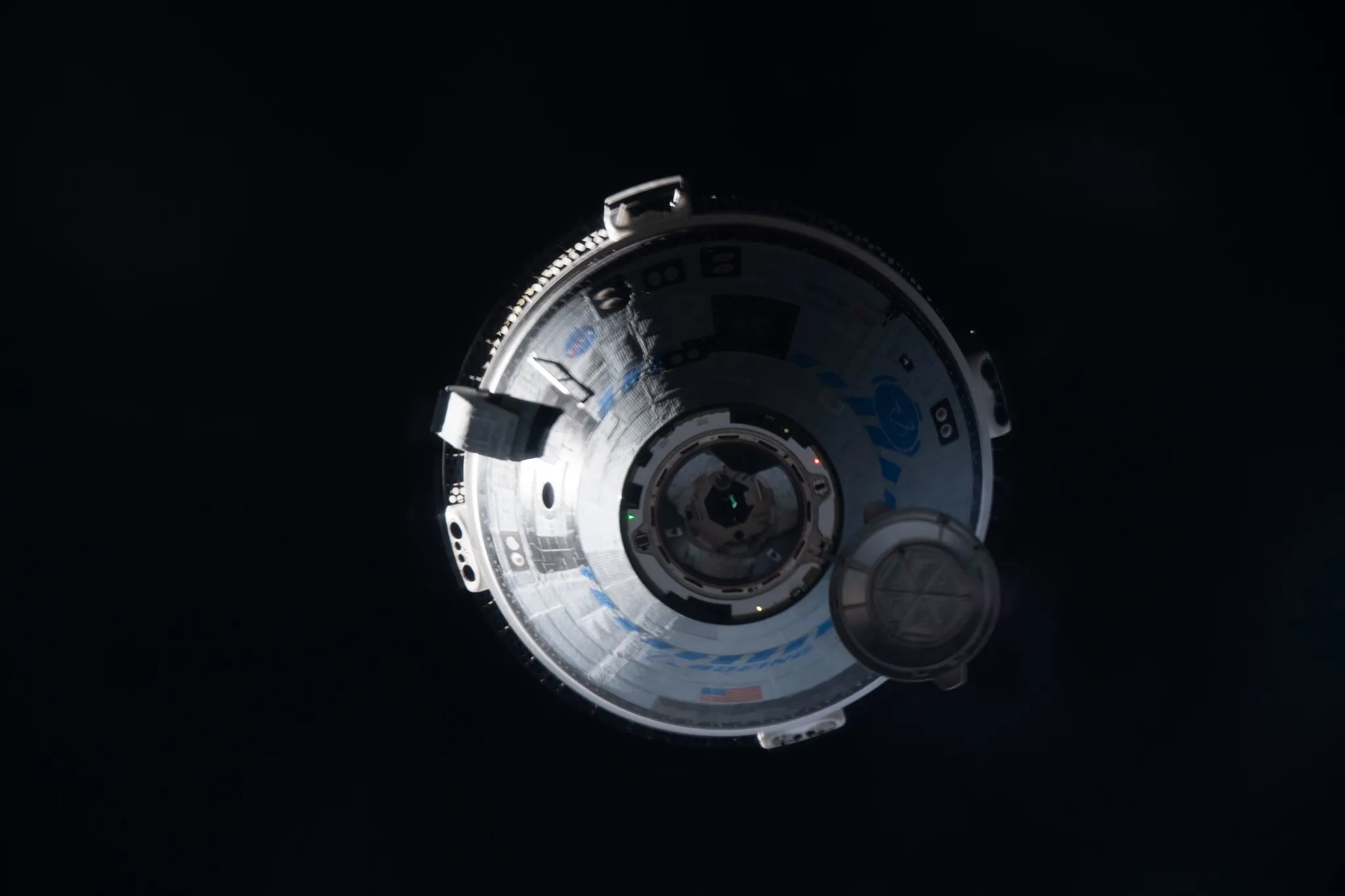
Boeing’s CST-100 Starliner crew ship approaches the International Space Station on the company’s Orbital Flight Test-2 mission before automatically docking to the Harmony module’s forward port.
NASA will provide live coverage of prelaunch and launch activities for the agency’s Boeing Crew Flight Test, which will carry NASA astronauts Butch Wilmore and Suni Williams to and from the International Space Station.
Launch of the ULA (United Launch Alliance) Atlas V rocket and Boeing Starliner spacecraft is targeted for 12:25 p.m. EDT Saturday, June 1, from Space Launch Complex-41 at Cape Canaveral Space Force Station in Florida. Starliner will dock to the forward-facing port of the station’s Harmony module at approximately 1:50 p.m., Sunday, June 2.
Wilmore and Williams will remain at the space station for about a week to test the Starliner spacecraft and its subsystems before NASA works to complete final certification of the transportation system for rotational missions to the orbiting laboratory as part of the agency’s Commercial Crew Program.
NASA, Boeing, and ULA scrubbed the previous launch opportunity on May 6 due to a suspect oxygen relief valve on the Atlas V rocket’s Centaur second stage. Since, teams have removed and replaced the valve, and completed an assessment of Starliner’s performance and redundancy after discovering a small helium leak in the spacecraft’s service module.
As part of the helium leak investigation, NASA and Boeing conducted a follow-on propulsion system assessment to understand potential helium system impacts to some Starliner return scenarios. NASA also completed a Delta-Agency Flight Test Readiness Review on May 29 to evaluate all work performed and flight rationale before proceeding toward launch.
The deadline for media accreditation for in-person coverage of this launch has passed. The agency’s media credentialing policy is available online. For questions about media accreditation, please email: ksc-media-accreditat@mail.nasa.gov.
NASA’s mission coverage is as follows (all times Eastern and subject to change based on real-time operations):
Friday, May 31
1 p.m. – Prelaunch briefing with the following participants:
- NASA Associate Administrator Jim Free
- Steve Stich, manager, NASA’s Commercial Crew Program
- Dana Weigel, manager, NASA’s International Space Station Program
- NASA astronaut Mike Fincke
- Mark Nappi, vice president and program manager, Commercial Crew Program, Boeing
- Gary Wentz, vice president, Government and Commercial Programs, ULA
- Mark Burger, launch weather officer, 45th Weather Squadron, Cape Canaveral Space Force Station
Coverage of the briefing will stream live on NASA+, NASA Television, the NASA app, YouTube, and the agency’s website.
Media may ask questions in person and via phone. Limited auditorium space will be available for in-person participation. For the dial-in number and passcode, media should contact the newsroom at NASA’s Kennedy Space Center in Florida no later than one hour before the start of the event at ksc-newsroom@mail.nasa.gov.
Saturday, June 1
8:15 a.m. – Launch coverage begins on NASA+, NASA Television, the NASA app, YouTube, and the agency’s website.
12:25 p.m. – Launch
Launch coverage on NASA+ will end shortly after Starliner orbital insertion. NASA Television will provide continuous coverage leading up to docking and through hatch opening and welcome remarks.
2 p.m. – Postlaunch news conference with the following participants:
- NASA Administrator Bill Nelson
- Ken Bowersox, associate administrator, NASA’s Space Operations Mission Directorate
- Steve Stich, manager, NASA’s Commercial Crew Program
- Dana Weigel, manager, NASA’s International Space Station Program
- Mark Nappi, vice president and program manager, Commercial Crew Program, Boeing
- Tory Bruno, president and CEO, ULA
Coverage of the postlaunch news conference will air live on NASA+, NASA Television, the NASA app, YouTube, and the agency’s website.
Media may ask questions in person and via phone. Limited auditorium space will be available for in-person participation. For the dial-in number and passcode, media should contact the Kennedy newsroom no later than three hours before the start of the event at ksc-newsroom@mail.nasa.gov.
NASA+ will resume coverage and NASA Television’s public channel will break from in-orbit coverage to carry the postlaunch news conference. Mission operational coverage will continue on NASA Television’s media channel and the agency’s website. Once the postlaunch news conference is complete, NASA+ coverage will end, and mission coverage will continue on both NASA channels.
Sunday, June 2
11:15 a.m. – Arrival coverage resumes on NASA+, the NASA app, and YouTube, and continues on NASA Television and the agency’s website.
1:50 p.m. – Targeted docking to the forward-facing port of the station’s Harmony module
3:35 p.m. – Hatch opening
3:55 p.m. – Welcome remarks
5 p.m. – Post-docking news conference at NASA’s Johnson Space Center with the following participants:
- NASA Associate Administrator Jim Free
- Steve Stich, manager, NASA’s Commercial Crew Program
- Dana Weigel, manager, NASA’s International Space Station Program
- Mark Nappi, vice president and program manager, Commercial Crew Program, Boeing
Coverage of the post-docking news conference will air live on NASA+, NASA Television, the NASA app, YouTube, and the agency’s website.
Quelle: NASA
+++
Boeing will try to launch its first crew on Starliner, again

Troubled aerospace giant Boeing will try once more to fly its first crew to the International Space Station aboard a Starliner spaceship on Saturday, after the last attempt was scrubbed hours before liftoff.
Following checks by engineering teams, NASA astronauts Butch Wilmore and Suni Williams are "go" for launch atop a United Launch Alliance rocket at 12:25 pm (1625 GMT) from the Cape Canaveral Space Force Station in Florida on Saturday. Weather is so far highly favorable.
"We are excited for launch, and we have every confidence in this mission," astronaut Mike Fincke, the backup crew member for the mission, told reporters in a press conference.
The US space agency is looking to certify Boeing as a second commercial operator to ferry crew to the orbital outpost -- something Elon Musk's SpaceX has already been doing since 2020.
Both companies received multi-billion-dollar contracts in 2014 to develop their gumdrop-shaped and autonomously piloted crew capsules, following the end of the Space Shuttle program in 2011 that left the US temporarily reliant on Russian rockets for rides.
Boeing, with its 100-year history, was heavily favored over its then-upstart competitor, but its program has faced years of delays and safety scares that mirror the myriad problems afflicting its commercial airline division.
Wilmore and Williams were strapped in and ready to blast off on May 6 when a faulty rocket valve forced ground teams to call off that launch.
- Urine pump -
Since then, a small helium leak located in one of the spacecraft's thrusters came to light -- but rather than replace the seal, which would require taking Starliner apart in its factory, NASA and Boeing officials declared it's safe enough to fly as is.
Final checks on the leak will take place in the hours before launch.
A successful flight would help Boeing dispel some of the reputational damage sustained by successive failures over the years -- from a software bug that put the spaceship on a bad trajectory on its first uncrewed test, to the discovery the cabin was filled with flammable electrical tape after the second.
It's also important for more immediate reasons: the Urine Processor Assembly on the ISS, which recycles water from the astronauts' urine, suffered a failure this week and its pump needs to be replaced, Dana Weigel, NASA's ISS program manager, told reporters.
This mission will thus be tasked with carrying spare equipment, which weighs around 150 pounds (70 kilograms). To make way for it, two astronauts' suitcases containing clothes and toiletries had to be pulled off, meaning they'll need to rely on backup supplies kept on the station.
If all goes according to plan, the Starliner should dock with the ISS on Sunday and remain there eight days as the crew carry out tests, including simulating whether the ship can be used as a safe haven in the event there is a problem on the ISS.
It would then undock, reenter the atmosphere and carry out a parachute and airbag-assisted landing in the western United States on June 10.
Quelle: SDNASA, Mission Partners Forgo June 2 Launch of Crew Flight Test
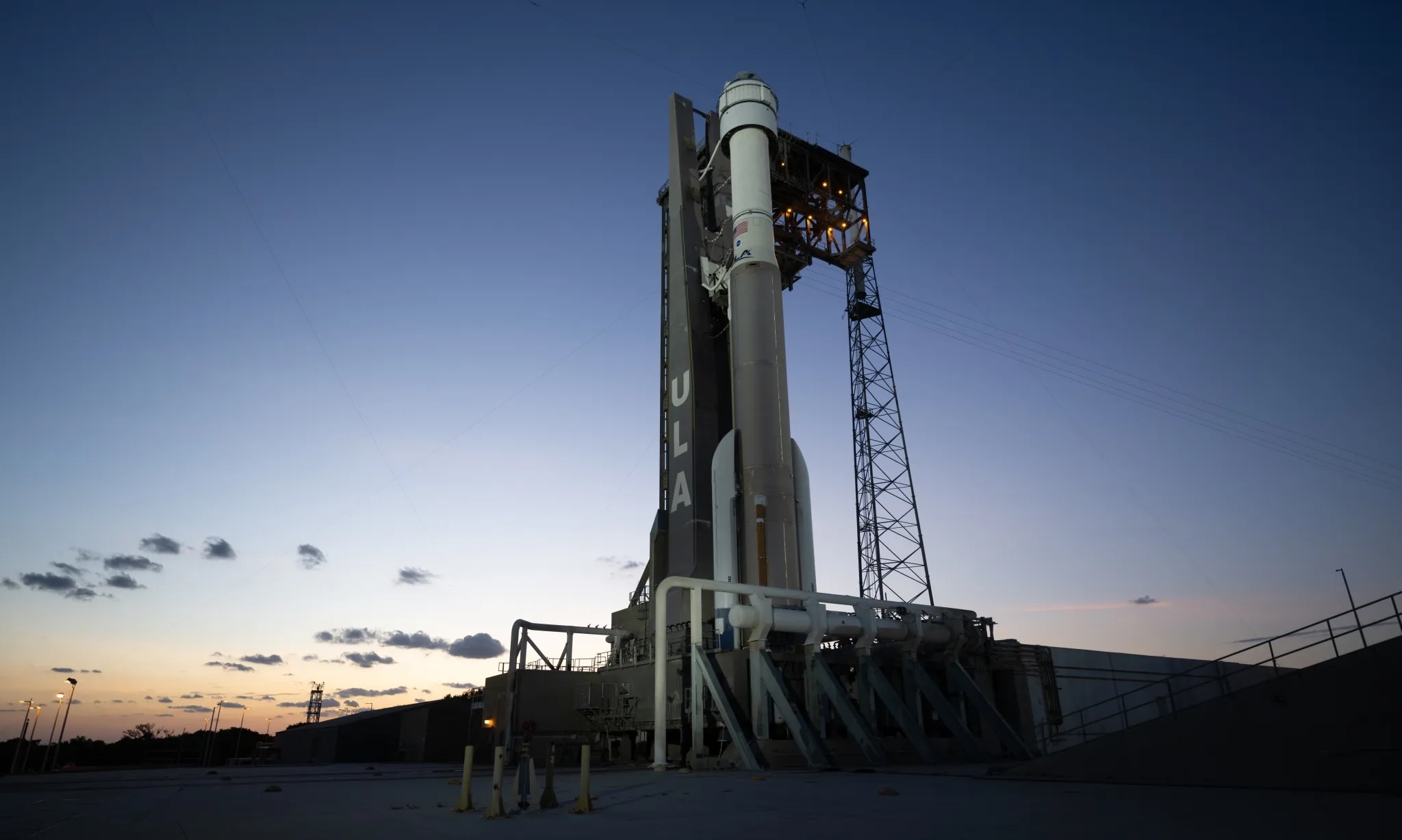
A United Launch Alliance Atlas V rocket with Boeing’s Starliner spacecraft aboard is seen at sunset on the launch pad at Space Launch Complex 41 ahead of the NASA’s Boeing Crew Flight Test, Friday, May 31, 2024 at Cape Canaveral Space Force Station in Florida. NASA’s Boeing Crew Flight Test is the first launch with astronauts of the Boeing spacecraft and United Launch Alliance Atlas V rocket to the International Space Station as part of the agency’s Commercial Crew Program. Photo Credit: NASA/Joel Kowsky
NASA, Boeing, and ULA (United Launch Alliance) are forgoing a Crew Flight Test launch attempt Sunday, June 2, to give the team additional time to assess a ground support equipment issue at Cape Canaveral Space Force Station’s Space Launch Complex-41 in Florida.
Saturday’s launch was to carry NASA astronauts Butch Wilmore and Suni Williams to and from the International Space Station scrubbed due to an observation of a ground launch sequencer. The system was unsuccessful in verifying the sequencer’s necessary redundancy.
ULA will assess the ground support equipment overnight, and NASA will provide an update June 2 on next steps for the flight. The next available launch opportunities are Wednesday, June 5, and Thursday, June 6.
Quelle: NASA

